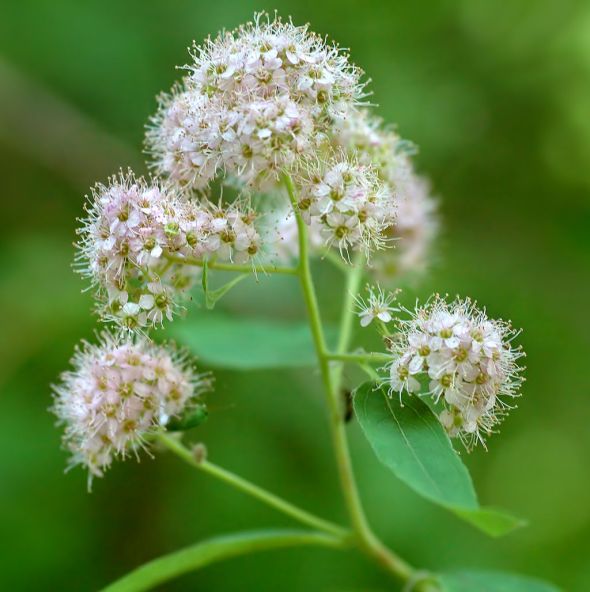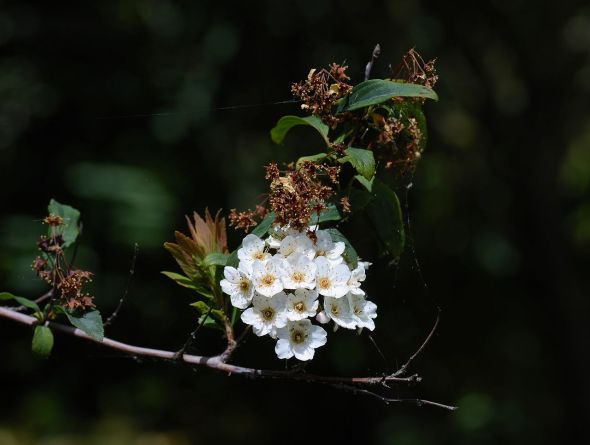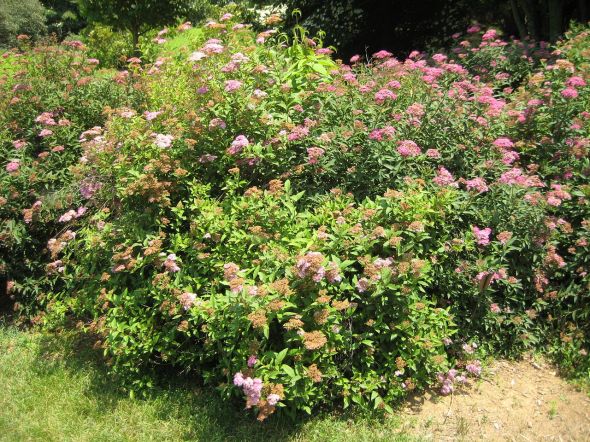How to Plant a Spirea Bush ~ Plant Care Guide
Spiraea /spaɪˈriːə/, is a genus of about 80 to 100 species of shrubs in the family Rosaceae. They are native to the temperate Northern Hemisphere, with the greatest diversity in eastern Asia.
The genus formerly included the herbaceous species now segregated into the genera Filipendula and Aruncus; recent genetic evidence has shown that Filipendula is only distantly related to Spiraea, belonging in the subfamily Rosoideae.
Spiraea plants are hardy, deciduous-leaved shrubs. The leaves are simple and usually short stalked, and are arranged in a spiralling, alternate fashion. In most species, the leaves are lanceolate (narrowly oval) and about 1 to 4 inches (2.5 to 10.2 cm) long. The leaf margins are usually toothed, occasionally cut or lobed, and rarely smooth. Stipules are absent.
The many small flowers of Spiraea shrubs are clustered together in inflorescences, usually in dense panicles, umbrella-like corymbs, or grape-like clusters. The radial symmetry of each flower is five-fold, with the flowers usually bisexual, rarely unisexual. The flowers have five sepals and five white, pink, or reddish petals that are usually longer than the sepals. Each flower has many (15 to 60) stamens. The fruit is an aggregate of follicles.
Species
- Spiraea affinis
- Spiraea alaskaense
- Spiraea alba – narrow-leaved meadowsweet, pale bridewort
- Spiraea albiflora
- Spiraea amoena
- Spiraea arcuata
- Spiraea baldschuanica
- Spiraea bella
- Spiraea betulifolia – white meadowsweet
- Spiraea blumei
- Spiraea calcicola
- Spiraea cana
- Spiraea canescens – Himalayan spiraea
- Spiraea cantoniensis – Reeve’s spiraea
- Spiraea chamaedryfolia – elm-leaf spiraea, germander meadowsweet
- Spiraea crenata
- Spiraea decumbens
- Spiraea douglasii – Douglas’ spiraea, steeplebush
- Spiraea gemmata
- Spiraea henryi
- Spiraea hypericifolia – Iberian meadowsweet
- Spiraea japonica – Japanese spiraea
- Spiraea lobata
- Spiraea longigemmis
- Spiraea media – Russian spiraea
- Spiraea micrantha
- Spiraea miyabei
- Spiraea mollifolia
- Spiraea nervosa
- Spiraea nipponica
- Spiraea prunifolia – bridal-wreath spiraea
- Spiraea pubescens
- Spiraea rosthornii
- Spiraea salicifolia – bridewort, willowleaf meadowsweet
- Spiraea sargentiana
- Spiraea septentrionalis – northern meadowsweet
- Spiraea splendens – rose meadowsweet
- Spiraea stevenii – beauverd spirea
- Spiraea thunbergii – Thunberg’s meadowsweet
- Spiraea tomentosa – hardhack, steeplebush
- Spiraea trichocarpa
- Spiraea trilobata – Asian meadowsweet
- Spiraea veitchii
- Spiraea virginiana – Virginia spiraea
- Spiraea wilsonii
- Spiraea yunnanensis
Hybrids
There are also numerous named hybrids, some occurring naturally in the wild, others bred in gardens, including several important ornamental plants:
- Spiraea × arguta (S. × multiflora × S. thunbergii) – garland spiraea
- Spiraea × billiardii (S. douglasii × S. salicifolia) – Billiard’s spiraea
- Spiraea × blanda (S. nervosa × S. cantoniensis)
- Spiraea × brachybotrys (S. canescens × S. douglasii)
- Spiraea × bumalda (S. japonica × S. albiflora)
- Spiraea × cinerea (S. hypericifolia × S. cana)
- Spiraea × conspicua (S. japonica × S. latifolia)
- Spiraea × fontenaysii (S. canescens × S. salicifolia)
- Spiraea × foxii (S. japonica × S. betulifolia)
- Spiraea × gieseleriana (S. cana × S. chamaedryfolia)
- Spiraea × macrothyrsa (S. douglasii × S. latifolia)
- Spiraea × multiflora (S. crenata × S. hypericifolia)
- Spiraea × notha (S. betulifolia × S. latifolia)
- Spiraea × nudiflora (S. chamaedryfolia × S. bella)
- Spiraea × pikoviensis (S. crenata × S. media)
- Spiraea × pyramidata (S. betulifolia × S. douglasii) – pyramid spiraea
- Spiraea × revirescens (S. amoena × S. japonica)
- Spiraea × sanssouciana (S. japonica × S. douglasii)
- Spiraea × schinabeckii (S. chamaedryfolia × S. trilobata)
- Spiraea × semperflorens (S. japonica × S. salicifolia)
- Spiraea × vanhouttei (S. trilobata × S. cantoniensis) – Van Houtte’s spiraea
- Spiraea × watsoniana (S. douglasii × S. densiflora)
http://en.wikipedia.org/wiki/Spiraea
~~~~~~~~~~~~~~~~~~~~~~~~~~~~~~~~~~~~~~~~~~~~
How to Plant a Spirea Bush ~ by Caryn Anderson
http://homeguides.sfgate.com/plant-spirea-bush-24222.html
 Adding a 2-inch layer of mulch helps discourage weeds from growing.
Adding a 2-inch layer of mulch helps discourage weeds from growing.
Spireas (Spiraea) fill the landscape with cascading clusters of flowers that bloom in spring and summer. These deciduous shrubs grow to heights and spreads of 2 to 10 feet, depending on the variety. They are hardy in Sunset Climate Zones 14 through 17. Spireas flourish in coastal and inland climates and are one of easiest types of flowering shrubs to grow, since they require minimal maintenance and adapt to a range of growing conditions.
Find a planting area that has well-draining soil, receives full to partial sun exposure and has enough space to accommodate the spirea’s projected mature size. Take spacing into consideration. Plan to allow 2 to 15 feet between plants, allowing more space between larger varieties of spirea.
- Dig a hole that is as deep as the spirea’s root ball and at least twice as wide to allow the roots to spread out. In general, you do not need to add anything to the soil or test its pH since spireas adapt to most types of soil. If the soil is very low in organic materials, mix about 1 inch of compost in with the garden soil while planting.
- Remove the plant from its container, gently loosening any roots that are wound tightly around the root ball. Place it upright in the hole and fill it in halfway with soil. Water the hole thoroughly, saturating the ground to remove any air pockets that may later damage the spirea’s roots. Wait until the water is absorbed to fill the hole completely with soil and water thoroughly again.
- Create a ring around the spirea’s hole, mounding soil 2 to 3 inches high to help hold water in the planting area. Distribute a layer of mulch about 2 inches thick around the planting area beyond the ring that you created. After the plant’s first season, remove the ring and place mulch closer to the plant.
- Water plants regularly throughout the growing season, adding an average of 1 inch of water weekly. Where you live may dictate how frequently you have to water your plants. For example, gardeners in coastal areas usually have sandy soil. Sandy soil drains faster than other types of soil, making it necessary for gardeners to water more frequently.
Things You Will Need
Spade
Garden tiller (optional)
Compost (optional)
Mulch
Planting times are flexible. Gardeners should plant spireas in spring or fall to allow young plants time to become established before summer.
About the Author
Caryn Anderson has been writing professionally since 2007. She specializes in a variety of subjects, including food and healthy recipes, pets and health. She is an avid gardener and travel enthusiast. Anderson holds her Bachelor of Science in communication studies from New York University.
Photo Credits
Jupiterimages/Photos.com/Getty Images
~~~~~~~~~~~~~~~~~~~~~~~~~~~~~~~~~~~~~~~~~~~~~~~
Care of Spirea ~ by Jackie Carroll
Spirea comes in a wide range of sizes and types, each with its own uses in the landscape. Small varieties, such as the 1.5-foot-tall Spirea japonica, work well as neat, rounded ground covers. Mid-sized plants, including most varieties of S. x cineria show best in foundation plantings and shrub borders. If you’re looking for an informal hedge or specimen plant, choose S. nipponica, S. prunifolia or S. vanhouttei, which grow to between 5 and 9 feet tall. Spring-blooming spireas generally have white flowers, while summer-blooming types usually bloom in shades of pink or red.
http://homeguides.sfgate.com/care-spirea-21670.html
Spirea ~ Spireas are small to medium sized deciduous shrubs that produce cascades of flowers in spring and summer.
http://www.garden.org/plantguide/?q=show&id=2103
Growing Spirea Shrubs: Information On How To Care For Spirea Bushes
http://www.gardeningknowhow.com/ornamental/shrubs/spirea/growing-spirea-shrubs.htm









I think the point is how to NOT grow a spiraea as they are SO hardy and resilient they make an amazing garden specimen for tough conditions. I hacked one to the ground that had grown out of my comfort zone and it’s back now…you just can’t kill them once they are established and that makes them an invaluable species in a garden to me. 🙂
June 19, 2014 at 6:29 pm
lol, me too 🙂 here they have gone rogue with the japonica not just me but the entire region, it is gorgeous though when in bloom … waves of color everywhere 🙂
June 19, 2014 at 10:38 pm
Sometimes its just good to know that SOMETHING in your garden is going to grow without being scoffed by a native animal or dying of heat stress or the cold. Spirea ticks all of those boxes and more AND the flowers are lovely 🙂
June 20, 2014 at 1:24 am
😀
June 20, 2014 at 4:05 pm